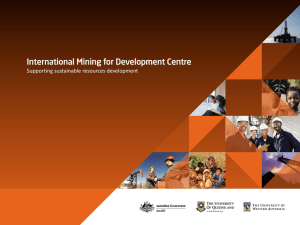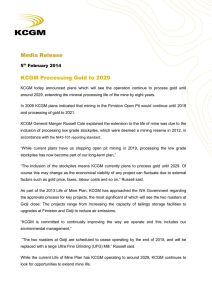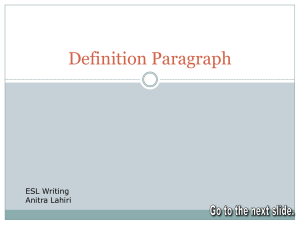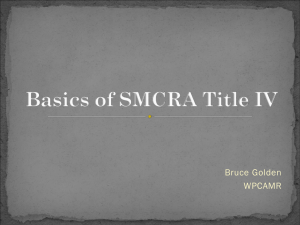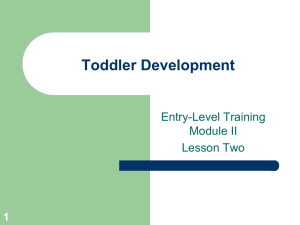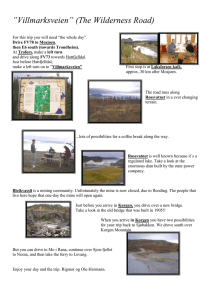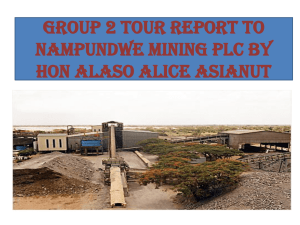ROK Case Study - Nautilus Institute for Security and Sustainability
advertisement
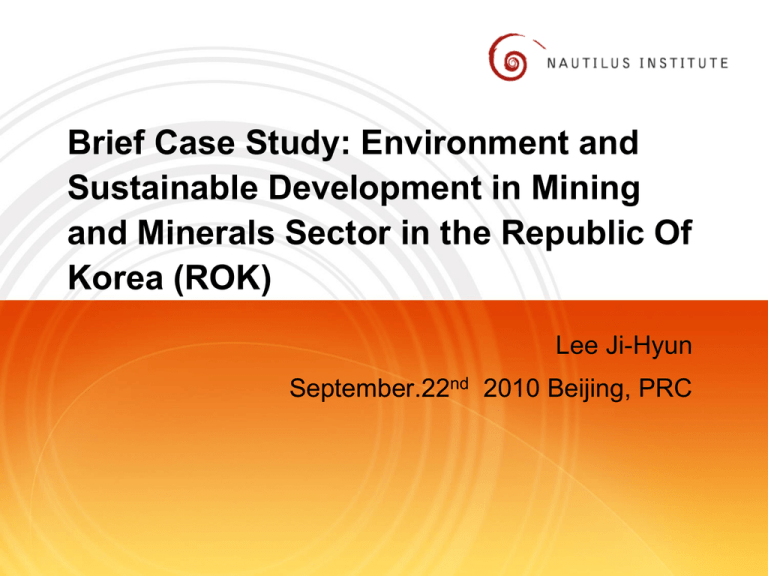
Brief Case Study: Environment and Sustainable Development in Mining and Minerals Sector in the Republic Of Korea (ROK) Lee Ji-Hyun September.22nd 2010 Beijing, PRC Contents Introduction Policies and legislation Planning Practice Case Conclusion Page 2 Introduction characteristics of the mining industry in S.Korea Weakness Minerals development encouraged from 1960 to 1980. However, limited reserves of mineral resources And the depletion of natural resources and decreasing price have caused the voluntary closure of non-economical mines and a reduction in mine production since 1990. Most are ‘medium–scale mining operators’ -> difficult to implement environmental best practice Opportunity Relatively recently economical importance of minerals and mining recognized again : the price of minerals in international market has been increased . Changes in awareness and policy on environment : GDP increased, Regulations and laws related to environment Page 3 Policies and legislation Sustainable Development Policy in mining & mineral sector The Mine Pollution Prevention and Reclamation Act was enacted on May 31st, 2005, and the Mine reclamation corporation was established in June 2006 to actively promote the mine reclamation project in closed mining areas. Purpose of enactment : 1. Most of mines in S.Korea were abandoned - severe environment and human health impacts. : As of 2005, inactive or abandoned mines accounts for 64% of whole mines. Companies no longer operating. : Harmful waste water containing such heavy metals as iron, aluminum, arsenic, and cadmium are being discharged from abandoned pits and waste stone and tailing dumping sites following the closure of mines. -> Led to a push for national actions for mine-hazard prevention Mines inactive/abandoned mines operational mines 36% Page 4 17% abandoned coal mines 47% Source: Korea Institute for Geosciences and Mineral Resources, 2005, Present Status of Abandoned Mines 2. Related laws and regulations were scattered and there was overlap on implementation by different departments -> need for unified mgt. system Waste stone, waste water, ground subsidence, abandoned equipment, plant and buildings Survey on land contamination Ministry of Knowledge & Economy : Ministry of Environment Ministry of Knowledge & Economy Waste stone, waste water, ground subsidence, abandoned equipment, plant and buildings , Restoration of Forest and Land Ministry for food, Agriculture, Forestry , and fisheries [After] Page 5 [Before] Soil Remediation Regulations and Laws on Mining and Mine Reclamation Regulation and Laws (From 1980 to 2005) • • • Since 2006 The Mine Safety Act • The Coal Industry Act • Other Environment Laws and Regul ations: The Soil Environment Conservation Act; The noise and vibration control Act; The wastes control Act ; The water quality and ecosystem conservation Act • The Agricultural Land Act • The Forest Act Page 6 The Mine Safety Act The Prevention of Mine Pollution and Reclamation Act Overview of the Prevention of mine pollution and reclamation Act 1 Legal obligation for government to put forward national action for prevention of mine hazard : legal obligation for mine operator is dismissed after three years from when the ‘mining right’ is expired. Then the government has legal obligation for abandoned mines in this case, and also in case of mine operator pass away or losing financial ability etc. (Article3) ** ‘Mine hazard’(mine pollution) is defined in related laws; the mining act, the mining safety act, the coal industry act, The Soil Environment Conservation Act, The Prevention of Mine Pollution and Reclamation Act** : According to the definition of laws, mining hazard is negative impacts on the environment and on human health that mining operations can lead to; such as land degradation, drainage from mining sites, including acid mine drainage and pumped mine water, dust emissions from sites close to living areas or habitats : Furthermore, The prevention of mine pollution and reclamation Act defines mining hazard containing social environment impact such as creating unsightly views or becoming a crime-ridden district since its abandonment. Page 7 - Overview of the Act 2 The share in expense for prevention of mine hazard (Article 24) : : Mine operator shall deposit a share for prevention of mine hazard every year during mining operation. It will be spent for rehabilitation after mine closure **Obligor of prevention of mine hazard(article 2): mining right holder and mining concession right holder . **Government subsidy regulated in the Special Account for Energy and Resouce Act, Article 5, in the Coal Industry Act (Article 27), in the Nature Protection Act (Article 49) Page 8 Overview of the Act 3 Planning for implementation of policy : . General planning for prevention of mine hazards (2007~2011) -According to the article 7 of the Prevention of Mine Pollution and Reclamation Act, the ROK government designs general planning every five years Page 9 Practices Initial Phase : Location of mining activites - Mining operations required to undertake an Environment Impact Assessment (EIA) according to the Act on EIA Operational phase - Coal Mine Metal Mine Non Metal mine Subtotal Total 349 988 669 1,657 2,006 Operational 9 Mine 52 669 721 730 Abandoned 340 Mine 936 0 936 1,276 Total Page 10 Tot al Page 11 Compensation for mine damage Post –closure mgt. forest Clean-up of Abandoned equipment and plan ts Restoration of Prevention of noise and vibration Remediation of soil Remediation of water quality Prevention of ground subsidence Prevention of tailing sweeping Prevention of waste stone Status of prevention of mine hazard for recent years 2006 16 6 3 11 - 2007 40 14 27 25 33 54 26 25 15 3 2008 27 19 35 29 54 26 9 37 19 - 2009 8 19 35 20 74 11 9 28 15 - 75 52 113 80 161 91 47 101 49 3 Recent case of mining hazard in ROK Jang-hang Refinery (copper) - Impact on residents around the refinery : Among residents, began to claim their cancer is caused by cadmium leaked by the refinery (1998) - JH refinery closed its smelting furnace in 1989 because of environment impacts such as cadmium emissions and increasing environmental expenses . -For about ten years, local government did not recognise claims of local communities. But, after Seo-cheon News newspaper, reported severe public health impacts from the refinery, it became a nationwide issue. Central government started to implement a precise survey on residents health status. After its results came out in 2009, the government put forward measures for residents health and remediation of soil around the refinery. The town of Jang-hang is located in Seo-cheon County in South Chung-chung Province. Page 12 Detailed Measure Purchase polluted lots ㆍBased on the soil precision survey, purchase soil centering around the section that was polluted by heavy metals and also polluted by multi materials. Purify polluted lots ㆍDivide into the section not to be purchased and the section to be purchased, purify them but the section not to be purchased shall be purified first. ㆍPurification expenses shall be shared according to the pollution causing rate of the institutions that manage the Janghang refinery. Designate a soil preservation measure region ㆍDesignate a pollution source section with the radius of around 1.5 km such as a section where tolerance standards on heavy metal residues in agricultural products(rice) are exceeded. (excluding factory regions). Enforce the migration of residents ㆍEnforce the migration of residents who reside within the section to be purchased. - Enforce compensation for prohibition on farming. ㆍEnforce rewards for a pollution source section with the radius of around 1 km where farming is prohibited since the heavy metal residues in agricultural products exceed the tolerance standard. Page 13 Conclusion The mechanism for environmentally sustainable development in mining and mineral sector in South Korea is government-oriented. Even mining operators have a responsibility to incorporate environment sustainabliltiy into their operation according to the laws, many of them are smaller scale mining and have less capability to afford shared expenses and low technology and skill. Also, many of mines in South Korea are inactive or abandoned , but it is rarely possible to find the previous mine operators and owners. Therefore, government, particularly the Ministry of Knowledge and Economcy and the Korea Mines Reclamation Corporation take on responsibilty. However, its budget is not sufficient to inspect mine hazards on a national scale and conduct the projects for prevention and reclamation management. The agena for the future is for the development and improvement of technology to manage and mitigate mine hazards during operations and address the rehabilitation of contaminated sites. Also to use systems such as GIS for completing an inventory of abandoned mines and damages. Page 14
